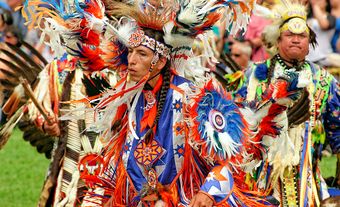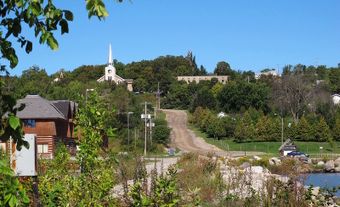The Mohawks of the Bay of Quinte are part of the Kanyen’kehá:ka or Mohawk Nation. Kanyen’kehá:ka means “People of the Land of Flint.” The Mohawk Nation is in turn part of the Rotinonhsyón:ni (Haudenosaunee or Six Nations Confederacy), which translates
in English to “People of the Longhouse.”
There are over 10,000 members of the Mohawks of the Bay of Quinte living on Turtle Island and beyond. About 2,200 of these members live on Tyendinaga Mohawk Territory. The Territory is located on the northeastern shore of the Bay of Quinte, just east of Belleville, Ontario.
Fort Hunter Mohawks and the American Revolution
The Mohawks of the Bay of Quinte are descendants of the Fort Hunter Mohawks. Until the American Revolution, the Fort Hunter Mohawks lived in the Mohawk Valley in what is now New York State.
During the American Revolution, the Rotinonhsyón:ni officially remained neutral, but men were free to fight. The Fort Hunter Mohawks allied with the British. In turn, the British promised to restore any losses sustained during the war. In 1777, following the Battle of Oriskany, the Americans and members of the Oneida Nation occupied Fort Hunter. The Fort Hunter Mohawks were forced to relocate and settled near Lachine, Quebec for the remainder of the war. The Treaty of Paris ended the war in 1783, but made no provision for Britain’s Rotinonhsyón:ni allies. The Fort Hunter Mohawks lost their homeland.

In 1783, a Fort Hunter Mohawks leader named Captain John Deserontyon, with the help of others, selected lands on the Bay of Quinte for a new home. These lands were important to Rotinonhsyón:ni. The north shore of Lake Ontario was part of the homelands of Iroquoian-speaking peoples before European contact and the location of 17th century Rotinonhsyón:ni communities. This area has been part of the vast wildlife harvesting area of Rotinonhsyón:ni for centuries.
In the spring of 1784, approximately 20 families set out from Lachine by canoe. They arrived on the shores of the Bay of Kente (now Quinte) on 22 May 1784. They started to build a new community, relying on a mixed economy of farming and harvesting.
Treaty 3½
On 1 April 1793, John Graves Simcoe, lieutenant governor of Upper Canada, executed a deed to the land the Fort Hunter Mohawks had chosen. The Simcoe Deed, also known as Treaty 3½, granted the land “To the Chiefs, Warriors, Women and People of the Six Nations” for their loyalty and “in recompense of the losses” sustained by them as a result of the American Revolution. The land was known as the Mohawk Tract. The tract was approximately 92,700 acres — less than a quarter of what the Fort Hunter Mohawks had selected. In addition to the tract being smaller than the land chosen, it was also smaller than the tract detailed in the deed itself. The Simcoe Deed describes a tract that is 12 miles along the Bay of Quinte and 13 miles deep, or 99,840 acres.

Throughout the 19th century, successive colonial administrations pressured the community to surrender all its lands and relocate to the Grand River, a larger Six Nations community. After the first surrender in 1820, the Mohawk Tract was renamed Tyendinaga Township by the Government of Upper Canada.
There were three large surrenders, and other smaller ones, amounting to the loss of two thirds of the land base. In the mid to late 20th century, some of these lands were returned. Today, Tyendinaga Mohawk Territory is about 18,000 acres. With recent land claims on the cusp of completion, the Mohawks of the Bay of Quinte anticipate land will continue to be returned to them.
Language
In the 1921 federal census, the mother tongue for all Mohawks of the Bay of Quinte members living on the Territory was reported as Kanyen’kéha. The language shift to English started in earnest in 1920 when the federal government took control of education on reserves as part of an assimilation agenda. The present-day percentage of MBQ membership with Kanyen’kéha as their mother tongue is less than 1 per cent. However, language revitalization efforts are increasing the percentage of members with Kanyen’kéha as a second language. These speakers have varying degrees of language proficiencies.
In the 1970s and 1980s, some remaining speakers informally taught Kanyen’kéha in their homes. In the 1970s, the Quinte Mohawk School, the community’s federally run elementary school, began providing Kanyen’kéha classes. In 1991, the off-reserve high school began offering a Kanyen’kéha course for students in grades 9 and 10. These courses are both still taught today.
In the late 1990s, Tsi Tyónnheht Onkwawén:na Language Circle (TTO) was founded to promote and revitalize Onkwehonwe’néha (original ways of being in the world; includes language, culture, traditions) in the community. Today, TTO offers an immersion-based approach for preschoolers (known as a “language nest”), Kawenna’ón:we Primary School for senior kindergarten to grade 4 and a certificate in Mohawk Language and Culture. The certificate program is delivered on Tyendinaga Mohawk Territory in partnership with Queen’s University.
Governance
The Kanyen’kehà: ka have three clans, Turtle, Wolf and Bear. Membership in these clans is passed down matrilineally from mother to child. Under the Great Law — the basis of Rotinonhsyón:ni society — everyone in the community has a voice. However, the clan mothers are responsible for nominating each clan’s chiefs.

In the early days, the community was governed in this traditional way. In the 1840s, the “old Chiefs” were paired with an elected council of men. This diminished the role of women in decision-making. In 1869, the Government of Canada passed the Gradual Enfranchisement Act. The act mandated fully elected councils in a municipal style and prevented the continuation of traditionally selected chiefs. The first election under this law was held in 1870. Women were not allowed to vote in these council elections until 1951.
The system imposed by the Gradual Enfranchisement Act remains part of the Indian Act today. The Mohawks of the Bay of Quinte elect one chief and four councillors every two years under this system.
From 1870 to the present, there have always been those who resisted this imposed system of governance.
Education
In 1784, a school was one of the first buildings constructed on Tyendinaga Mohawk Territory. Most students were formally educated at “day schools” in the community. By the early 20th century, there were four such schools. In 1955, Quinte Mohawk Day School (QMS) was built to centralize grades 5 through 8. These schools were eventually replaced by a new, larger school (also called QMS) in 1974. This school is one of six in Ontario that remains federally operated by Indigenous Services Canada. Other educational facilities located on the Territory include those previously mentioned as operated by Tsi Tyónnheht Onkwawén:na Language Circle (see “Language”), the First Nations Technical Institute (FNTI) and the Ohahase (New Road) Education Centre.
Some children of the community were sent to residential schools. More than 100 children were sent to the Mohawk Institute in Brantford from about 1862 to 1962. In addition, more than 15 were sent to the Shingwauk Home in Sault Ste. Marie.

Military Service
The warrior tradition runs deep in Rotinonhsyón:ni communities. Members of the Mohawks of the Bay of Quinte served in the War of 1812, the Upper Canada Rebellion of 1837, the First World War, the Second World War, Korea, Vietnam and Afghanistan. During the First World War, over 95 men volunteered, dozens were wounded and 22 did not return home. Community members have also served in the US forces and the Royal Navy. Territory lands were used for pilot training in the First World War at Camp Mohawk and in the Second World War at the Mohawk Aerodrome.
Community Highlights
Christ Church, Her Majesty’s Chapel Royal of the Mohawk, was built in 1843 to replace the community’s original church. It was designated a national historic site in 1995 and named a Chapel Royal in 2004. Other centres of worship include All Saints Anglican Church and Mohawk Pentecostal Church. The community’s first traditional longhouse, built in 2003, was destroyed by fire and rebuilt in 2012.

The “Landing of the Mohawks” on the shores of the Bay of Quinte is re-enacted annually on the weekend closest to May 22, the actual date of the Landing in 1784. The Mohawk Agricultural Fair also occurs annually on the third weekend of September. The fair showcases community gardens, livestock and judged competitions for baking, sewing and handiwork. The Mohawk Agricultural Society has organized and run the fair since 1901.
The Tyendinaga Traditional Pow Wow is held on the second weekend of August at Tsi Tkeritoton Park. An annual event since 1987, it attracts a wide array of dancers, singers, vendors and spectators each year.

 Share on Facebook
Share on Facebook Share on X
Share on X Share by Email
Share by Email Share on Google Classroom
Share on Google Classroom





